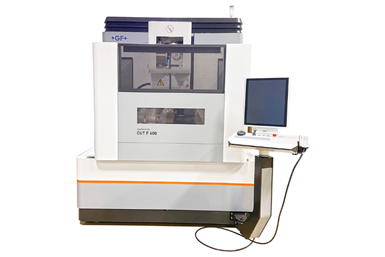GF Machining Solutions EDM Features Enhanced Control
The Cut F 600’s iWire function automatically identifies and adapts wire speed to changing erosion height conditions during the wire EDM process, eliminating wire breakage while reducing overall wire consumption.
Share



Takumi USA
Featured Content
View More




GF Machining Solutions Cut F 600 EDM is designed for ease of use and flexibility. It features the Uniqua control, ISPS and iWire intelligent functions and RFID Smart Wire system, along with design enhancements for thermal stabilization, vibration control and machine movement precision.
The Cut F 600’s Uniqua human-machine interface (HMI) features a 19" vertical touchscreen, full keyboard and mouse. It supports legacy file types from various EDM manufacturers, and with offline and at-the-machine programming, ISO-based functionality and object-oriented programming, Uniqua provides a powerful graphic tool with integrated CAM and also ensures compatibility with major CAD/CAM programs.
The iWire function of the Cut F 600 automatically identifies and adapts wire speed to changing erosion height conditions during the wire EDM process. This capability eliminates wire breakage while reducing overall wire consumption per job, in some instances by as much as 29%. The iWire function works in tandem with the company’s Intelligent Spark Protection System (ISPS), both of which are part of the Uniqua control.
iWire can not only recognize exactly where the sparks of a wire EDM are happening during the process, it can also measure and identify the position of each spark along the length of an EDM’s wire. Knowing the exact location of a spark enables iWire to automatically adapt the wire spool speed accordingly. Such capability reduces the chances of wire breakage during unattended operations when EDMing parts with steps and other features that vary the erosion height.
For increased precision machine movement, vibration control and overall process stability, the Cut F Series machines provide cooling of axis optical encoders using the worktank and the dielectric fluid. The other design change is the incorporation of higher accuracy machine ballscrews that improve both positioning accuracy and smoothness.
Related Content
-
Lean Approach to Automated Machine Tending Delivers Quicker Paths to Success
Almost any shop can automate at least some of its production, even in low-volume, high-mix applications. The key to getting started is finding the simplest solutions that fit your requirements. It helps to work with an automation partner that understands your needs.
-
How to Determine the Currently Active Work Offset Number
Determining the currently active work offset number is practical when the program zero point is changing between workpieces in a production run.
-
How to Successfully Adopt Five-Axis Machining
While there are many changes to adopt when moving to five-axis, they all compliment the overall goal of better parts through less operations.








































